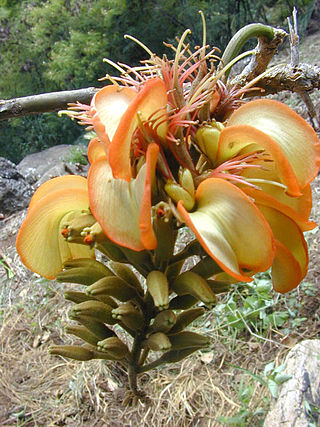
Wiliwili is a species of tree in the pea family, Fabaceae, that is endemic to the Hawaiian Islands. It is the only species of Erythrina that naturally occurs there. It is typically found in Hawaiian tropical dry forests on leeward island slopes up to an elevation of 600 m (2,000 ft).

The Hawaiian tropical rainforests are a tropical moist broadleaf forest ecoregion in the Hawaiian Islands. They cover an area of 6,700 km2 (2,600 sq mi) in the windward lowlands and montane regions of the islands. Coastal mesic forests are found at elevations from sea level to 300 m (980 ft). Mixed mesic forests occur at elevations of 750 to 1,250 m, while wet forests are found from 1,250 to 1,700 m. Moist bogs and shrublands exist on montane plateaus and depressions. For the 28 million years of existence of the Hawaiian Islands, they have been isolated from the rest of the world by vast stretches of the Pacific Ocean, and this isolation has resulted in the evolution of an incredible diversity of endemic species, including fungi, mosses, snails, birds, and other wildlife. In the lush, moist forests high in the mountains, trees are draped with vines, orchids, ferns, and mosses. This ecoregion includes one of the world's wettest places, the slopes of Mount Waiʻaleʻale, which average 373 in (9,500 mm) of rainfall per year.

Polyscias racemosa, or false 'ohe, is a species of flowering plant in the family Araliaceae. As Munroidendron racemosum, the species was until recently considered to be the only species in the monotypic genus Munroidendron. With the change in classification, Munroidendron is now obsolete. Polyscias racemosa is endemic to the Hawaiian island of Kauai. It is very rare in the wild and some of its original habitat has been replaced by sugar cane plantations. It was thought for some time to be probably extinct, but was rediscovered a few years prior to 1967.
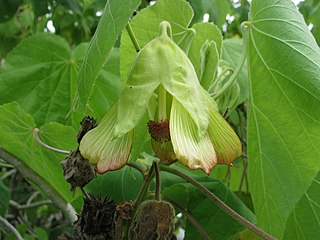
Abutilon sandwicense, commonly known as the greenflower Indian mallow, is a species of flowering plant in the mallow family, Malvaceae, that is endemic to the island of Oʻahu, Hawaii, in the United States. It inhabits dry forests on the slopes of the Waiʻanae Range at elevations of 400–600 m (1,300–2,000 ft). Associated plants include lama, ēlama, māmaki, kalia, āulu, olopua, and alaheʻe. Greenflower Indian mallow is a shrub, reaching a height of 1.5–3 m (4.9–9.8 ft). It is threatened by habitat loss.
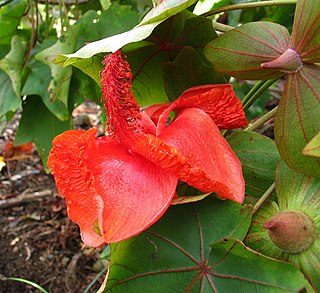
Kokia drynarioides, commonly known as Hawaiian tree cotton, is a species of flowering plant in the mallow family, Malvaceae, that is endemic to the Big Island of Hawaii. It inhabits dry forests at elevations of 455–1,915 m (1,493–6,283 ft). Associated plants include ʻāheahea, ʻaʻaliʻi, hala pepe, wiliwili, uhiuhi, kōlea, ʻaiea, kuluʻī, ʻālaʻa, ʻohe kukuluāeʻo, māmane, and maua. It is threatened by habitat loss and competition with invasive species, such as fountain grass.
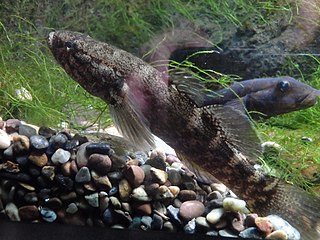
Eleotris sandwicensis, the Sandwich Island sleeper, Hawaiian sleeper or oopu, is a species of fish in the family Eleotridae endemic to the Hawaiian Islands, where it can be found in marine, fresh, and brackish waters around the coast. Due to this capability of migrating between different marine environments, they are amphidromous. This fish can reach a length of 33 cm (13 in). It is locally important to commercial fisheries and is also used as bait by fishermen after larger fishes. In the Hawaiian language, the fish is also known as oʻopu, ʻoau, ʻowau, and hiʻu kole.

Euphorbia haeleeleana, the Kauaʻi spurge, is a species of flowering plant in the croton family, Euphorbiaceae, that is endemic to the islands of Kauaʻi and Oaʻhu in Hawaii. Like other Hawaiian spurges it is known as `akoko.

Melicope knudsenii, commonly known as Olokele Valley melicope or Knudsen's melicope, is a species of flowering plant in the family Rutaceae, that is endemic to Hawaii. It inhabits montane mesic forests dominated by Acacia koa, Metrosideros polymorpha, and Dicranopteris linearis on Kauaʻi and East Maui (Auwahi). Associated plants include Syzygium sandwicensis, Cheirodendron trigynum, Myrsine lessertiana, Ilex anomala, Alphitonia ponderosa, Zanthoxylum dipetalum, Kadua terminalis, Pleomele aurea, Bobea spp., Tetraplasandra waimeae, Xylosma hawaiensis, Eurya sandwicensis, Psychotria mariniana, Melicope anisata, Melicope barbigera, Planchonella sandwicensis, Dodonaea viscosa, and Dianella sandwicensis. It is threatened by habitat loss. Like other Hawaiian Melicope, this species is known as alani. This is a federally listed endangered species of the United States.

Polyscias sandwicensis, known as the 'ohe makai or ʻOhe kukuluāeʻo in Hawaiian, is a species of flowering plant in the family Araliaceae, that is endemic to Hawaii. It is a tree, reaching a height of 4.6–15 m (15–49 ft) high with a trunk diameter of 0.5–0.6 m (1.6–2.0 ft). It can be found at elevations of 30–800 m (98–2,625 ft) on most main islands. Polyscias sandwicensis generally inhabits lowland dry forests, but is occasionally seen in coastal mesic and mixed mesic forests. It is threatened by habitat loss.

Cellana sandwicensis, common name the yellow-foot ʻopihi, is a species of edible true limpet, a marine gastropod mollusc in the family Nacellidae, one of the families of true limpets.
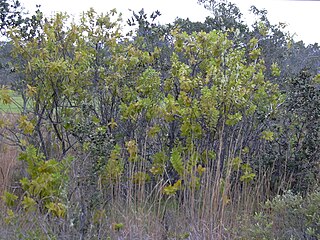
The Hawaiian tropical dry forests are a tropical dry broadleaf forest ecoregion in the Hawaiian Islands. They cover an area of 6,600 km2 (2,500 sq mi) on the leeward side of the main islands and the summits of Niʻihau and Kahoʻolawe. These forests are either seasonal or sclerophyllous. Annual rainfall is less than 127 cm (50 in) and may be as low as 25 cm (9.8 in); the rainy season lasts from November to March. Dominant tree species include koa, koaiʻa, ʻakoko, ʻōhiʻa lehua, lonomea, māmane, loulu, lama, olopua, wiliwili, and ʻiliahi. Endemic plant species in the dry forests include hau heleʻula, uhiuhi, and Gouania spp. The palila, a Hawaiian honeycreeper, is restricted to this type of habitat.

Nestegis sandwicensis, commonly known as Hawai'i olive or olopua, is a species of flowering tree in the olive family, Oleaceae, that is endemic to Hawaii. It is found on all major islands at elevations of 30–1,300 m (98–4,265 ft) in coastal mesic and mixed mesic forests, and, especially, dry forests. It usually reaches a height of 6 m (20 ft) with a trunk diameter of 0.2 m (0.66 ft), but may reach 20 m (66 ft) in height with a trunk diameter of 0.9 m (3.0 ft).

Diospyros sandwicensis is a species of flowering tree in the ebony family, Ebenaceae, that is endemic to Hawaii. It belongs to the same genus as both persimmons and ebony. Its common name, lama, also means enlightenment in Hawaiian. Lama is a small to medium-sized tree, with a height of 6–12 m (20–39 ft) and a trunk diameter of 0.3 m (0.98 ft). It can be found in dry, coastal mesic, mixed mesic, and wet forests at elevations of 5–1,220 m (16–4,003 ft) on all major islands. Lama and olopua are dominant species in lowland dry forests on the islands of Maui, Molokaʻi, Kahoʻolawe, and Lānaʻi.
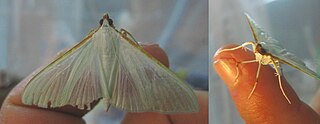
Stemorrhages is a genus of moths of the family Crambidae described by Julius Lederer in 1863. Members of the moth genus Palpita may be very similar.

Rhus sandwicensis, commonly known as neneleau, neleau or Hawaiian sumac, is a species of flowering plant in the cashew family, Anacardiaceae, that is endemic to Hawaii. It is small tree, reaching a height of 4.5–7.5 m (15–25 ft) and a trunk diameter of 10–30 cm (3.9–11.8 in). Neneleau inhabits dry, coastal mesic, mixed mesic and wet forests at elevations of 180–610 m (590–2,000 ft) on all main islands.

Planchonella sandwicensis is a species of flowering tree in the sapodilla family, Sapotaceae, that is endemic to the main islands of Hawaii. Names for this species in the Hawaiian language include ʻĀlaʻa, Āulu and ʻĒlaʻa.

Rauvolfia sandwicensis, the devil's-pepper, also known as hao in the Hawaiian language, is a species of flowering plant in the milkweed family, Apocynaceae, that is endemic to Hawaii. It is a shrub, a small tree reaching 6 m (20 ft) in height, or, rarely, a medium-sized tree up to 12 m (39 ft) tall with a trunk diameter of 0.3 m (0.98 ft). Hao inhabits coastal mesic and mixed mesic forests at elevations of 100–500 m (330–1,640 ft).
Udea platyleuca is a moth of the family Crambidae. It is endemic to the Hawaiian islands of Oahu, Molokai, Maui and Hawaii.
Eccoptocera foetorivorans is a moth of the family Tortricidae. It was first described by Arthur Gardiner Butler in 1881. It is endemic to the Hawaiian islands of Kauai, Oahu, Molokai, Maui, Lanai and Hawaii.
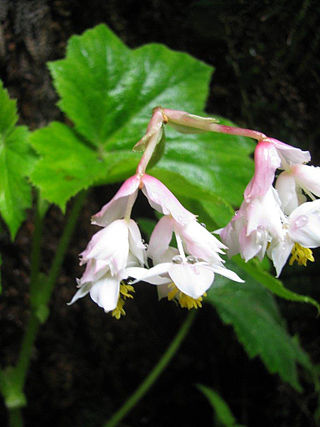
Hillebrandia sandwicensis is a species of a herbaceous perennial flowering plant native to some of the Hawaiian Islands. Common names include ʻakaʻakaʻawa and puʻa maka nui. The genus name honors the German physician William Hillebrand.

















